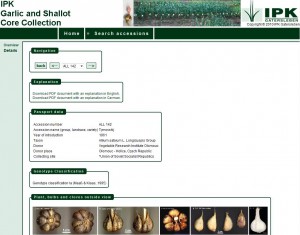 A new paper in GRACE from our friends at IPK sent me scurrying to check out a new database. The snappily titled “The Garlic and Shallot Core Collection image database of IPK presenting two vegetatively maintained crops in the Federal ex situ genebank for agricultural and horticultural crops at Gatersleben, Germany,” by Christian Colmsee et al., describes the Garlic and Shallot Core Collection Database (GSCC). This database provides very nice photographs and morphological descriptor information on each accession in said core collection. You can get data on the whole collection, minus the photos, from IPK’s main database. And much the same minus the characterization data in Eurisco, but then you get all the other European Allium collections as well. ((Go to Genesys if you want to look at the USDA’s collection at the same time.)) I haven’t found a way to search either the core collection or the full collection on the basis of specific characterization descriptors but who knows, maybe the photos are enough for most Allium germplasm users. Perhaps someone from IPK can drop us a comment on their future plans for these databases.
A new paper in GRACE from our friends at IPK sent me scurrying to check out a new database. The snappily titled “The Garlic and Shallot Core Collection image database of IPK presenting two vegetatively maintained crops in the Federal ex situ genebank for agricultural and horticultural crops at Gatersleben, Germany,” by Christian Colmsee et al., describes the Garlic and Shallot Core Collection Database (GSCC). This database provides very nice photographs and morphological descriptor information on each accession in said core collection. You can get data on the whole collection, minus the photos, from IPK’s main database. And much the same minus the characterization data in Eurisco, but then you get all the other European Allium collections as well. ((Go to Genesys if you want to look at the USDA’s collection at the same time.)) I haven’t found a way to search either the core collection or the full collection on the basis of specific characterization descriptors but who knows, maybe the photos are enough for most Allium germplasm users. Perhaps someone from IPK can drop us a comment on their future plans for these databases.
Nibbles: Chickens, Millet adoption, Specialty crops, World Food Day, Migrating forests, Vietnamese pheasants, Yews, High prices, Genebank tour, Climate change conference.
- Why did the Chinese chicken cross the road? To get a new date. For domestication, that is.
- The Indian Farmer is actually three, millet-wise.
- USDA wades into specialty crops. Wonder if one of them is baobab, and a factsheet is involved. Or “small scale grains” for that matter.
- “Life in the countryside is hard.” But fear not, FAO is on it.
- Forests are not migrating. Species are actually undergoing range contraction at both ends. Well that’s weird.
- The first pheasant extinction? Say it ain’t so.
- I like pictures of old trees. So sue me.
- Jess stops traffic.
- Tour a cocoa genebank. Could this catch on?
- International Conference on Climate Change and Food Security (ICCCFS). Not hot air.
Brave New Grispworld
What IRRI’s DDG doesn’t mention in this video is that all those accessions (or many of them anyway) whose genomes are going to be painstakingly sequenced for the greater good of rice breeders everywhere are maintained, and have been for years, in the IRRI genebank. So I’m happy to say it for him. The international collections maintained by the CGIAR Centres are often called the crown jewels of the system. Cinderellas, more like.
And where is Luigi now?
Due to overwhelming popular demand, ((Not really. Ed.)) here’s the next instalment of Luigi’s tour of Caucasus genebanks. Below is the site of the Scientific Center of Agrobiotechnology of the Ministry of Agriculture, which houses the Armenian national genebank, and is one of the key stakeholders in the national plant genetic resources programme. It is located in Echmiadzin (Էջմիածին), about a half hour drive to the west of Yerevan. A couple hundred meters north of the institute is the Mother Cathedral of Holy Etchmiadzin, the central cathedral of the Mother See of Holy Etchmiadzin of the Armenian Apostolic Church. The national genebank boasts something like 450 wheat, 300 chickpea and 100 capsicum accessions, among others. The Mother Cathedral of Holy Etchmiadzin boasts three pieces of the True Cross and a bit of Noah’s Ark.
Nibbles: GMO tomatoes, Achocha, Biofortified beans,
- “These awful tomatoes are genetically modified organisms, (GMOs)”. Oh, really? I do wish I didn’t have to naysay quite so often.
- Cyclanthera pedata, in all its Himalayan glory. I’ve grown achocha, and it is a wonderful plant to have around. There, I yea-sayed!
- A new spin on “biofortified”. Beans biofortied “against excess heat, drought, water and pests”.